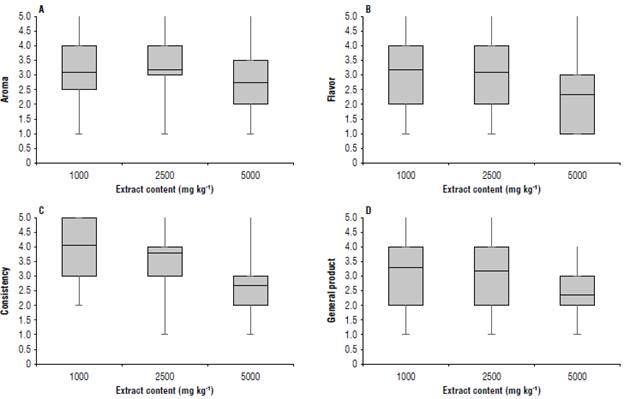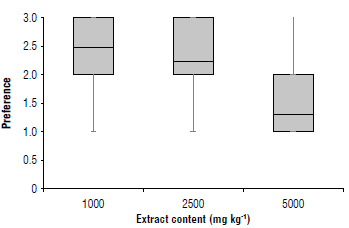Introduction
Nasturtium (Tropaeolum majus L.) is a climbing plant of South American origin belonging to the Tropaeolaceae family (Brondani et al., 2016), characterized by its round, peltate leaves and orange, yellow, and red flowers (Hegnauer, 1973). Its application is mainly ornamental, although it has also been used in traditional oral medicine for treatment of respiratory and skin infections (Alonso & Desmarchelier, 2015). These applications are attributed to bioactive compounds found in the plant, such as carotenoids, anthocyanins, glucosinolates and phenolic compounds (quercitrin, flavanols, gallic acid, caffeic acid, coumaric acid, chlorogenic acid) (Martínez-Navarrete et al., 2008; Jakubczyk et al., 2018; Demasi et al., 2021). Due to the nasturtium attributes, the extraction of its bioactive compounds has been carried out through different methods, using solvents such as methanol (Navarro-González et al., 2015; Demasi et al., 2021) or acetone (Amiri, 2012), the Soxhlet method (Fernandes et al., 2017) and new technologies such as ultrasound-assisted extraction (Jha Kumar & Sit, 2022); the extraction of phenolic and antioxidant compounds has been carried out using ABTS, DPPH methods (Garzón & Wrolstad, 2009; Arellano et al., 2015), FRAP methods and HPLC (Garzón et al., 2015; Navarro-González et al., 2015). Despite this, there is still no application of these extracts or the plant in food products. Also, there are no antecedents or previous toxicological studies related to the intake of nasturtium. Therefore, the objective of this study was to do a sensory evaluation for the feasibility of adding nasturtium extract to a nectar-type drink, potentiating a novel beverage. It is important to clarify that this study is not trying to evaluate the interaction or antagonism between the components of the nectar drink and the extract.
Materials and methods
Plant material preparation
The nasturtium was harvested in the town of Cogua, in the department of Cundinamarca, Colombia and taken to the Pontificia Universidad Javeriana (Bogotá, Colombia), where it was separated into leaves, flowers, and calyx. Subsequently every part was freeze-dried in a FreeZone 4.5 LABCONO freeze-dryer at a temperature of -80°C and a pressure of 0.120 mbar and later ground in a Kitchen Aid grinder, to be packaged and stored at -20°C. For the extraction and evaluation methods, only the nasturtium leaves were used.
Extraction
Solvent extraction water-ethanol was performed at room temperature, under constant stirring for 48 h, employing 5 g of the nasturtium leaves. Then, the solvent was filtered and concentrated in an IKA brand RV 10 digital V rotary evaporator, at a bath temperature of 50°C, rotation speed of 55 rpm and absolute vacuum of 100 mbar. Two extraction factors were evaluated: solute-solvent ratio (1:10 and 1:15 w/w), and ethanol purity in the solvent mixture (45%, 70% or 96%), performing six treatments in total and three replicates for every treatment, with the same extraction conditions. For every treatment, a new extraction was developed. A two-way analysis of variance and the interaction was performed for the statistical analysis, in addition to Tukey's multiple comparison test.
Determination of antioxidant capacity and total phenolic compounds
The antioxidant capacity of the extract was determined by the FRAP spectrophotometric method following the method of Demasi et al. (2021), to include many compounds such as antioxidants, phenolic compounds, and vitamin C; the results were expressed in units of Trolox Equivalent Antioxidant Capacity - TEAC (μmol Trolox/g extract). The content of total phenolic compounds was analyzed by the Folin-Ciocalteu method (Navarro-González et al., 2015), and the results were expressed in mg gallic acid equivalents / g extract. Each of the six treatments was analyzed in triplicate.
Beverage development
A nectar-type drink of tropical fruits and vegetables was made: 25% w/w 'Valencia' orange juice (Citrus sinensis [L.] Osbeck), 23% w/w yacon pulp (Smallanthus sonchifolius [Pöpp. & Endl.] H. Rob.), 16% w/w 'Granny Smith' apple pulp (Malus domestica Borkh.), 10% w/w chayote pulp (Sechium edule [Jacq.] Swartz), 12% w/w of an infusion of mint (Mentha spicata L.) at 5% w/w and 11% w/w cucumber pulp (Cucumis sativus L.). A known concentration of the extract was added to this drink (see the sensory analysis method), together with additives such as xanthan gum (0.2%), maltodextrin (1%) and 1% of a commercial sweetener, Best4u (https://fitmarketbogota.co/products/endulzante-natural-250gr-best4u), which is a mixture of erythritol and stevia.
Sensory analysis
Three beverages were prepared with different extract content: 1000, 2500, or 5000 mg extract/kg beverage (the extract used in this experiment was obtained with ethanol with 70% of purity and relation solute-solvent 1:10; this extract had one of the highest total phenolic compounds compared to the other extracts evaluated). The beverages were analyzed through an affective test (hedonic scale of 5 points: 1: I dislike it very much, 2: I dislike it a little, 3; I neither like nor dislike it, 4: I like it a little, 5: I like it a lot) with 60 untrained consumers, evaluating three attributes (aroma, flavor, consistency) and the product in general. Each consumer was given 20 ml of each sample in glasses coded with 3 random digits, at a temperature of 10°C. In addition, a preference test was conducted, in which the evaluator was asked to place the sample code in front of the phrase that most identified it: "the one that I like the most - the one that follows me in taste - the one that I like the least."
For statistical analysis, an analysis of variance (ANOVA) was performed. When the results did not present normality, a non-parametric Kruskal-Wallis analysis was performed, with a confidence level of 95%.
Results and discussion
Antioxidant capacity and total phenolic compounds
Table 1 presents the six experimental samples and their antioxidant capacity and total phenolic compounds.
TABLE 1 Antioxidant capacity average and content of total phenolic compounds average of the beverages evaluated.

1TEAC, 2mg gallic acid equivalent/g extract, 3 PSD - Pooled Standard Deviation.
The experiments obtained values higher than those reported by others, with 12.95 mg gallic acid equivalent/g for the content of phenolic compounds reported by Navarro-González et al. (2015) and 9.51 TEAC and 14.2 TEAC for the antioxidant capacity reported by Navarro-González et al. (2015) and Demasi et al. (2021), respectively. Both studies carried out extractions with methanol-water, a solvent mostly used for the extraction of bioactive compounds; however, due to its toxicity when ingested (Alcalá Pedrajas, 2002, it is necessary to review other solvents with equal or better yields to be used in edible products. Therefore, extraction with food-grade ethanol is a good replacement for methanol.
Extracts 4 and 5 had higher antioxidant capacity (Tab. 1), both with the highest solute-solvent ratio evaluated (1:15). Similar results were obtained by Yang and Li (2022), in which a ratio of 1:20 (the largest evaluated in the study) was the one with the highest antioxidant capacity in an extraction with 80% methanol solvent from the Angelica dahurica (Fisch.) Benth. & Hook plant. Sample 1, with a ratio of 1:10 and 96% ethanol, obtained the lowest value for total phenolic compounds, while samples 2 (70% ethanol - ratio 1:10) and 6 (45% ethanol - ratio 1:15) obtained the highest value for phenolic compounds. Both samples had solvent mixtures (ethanol-water); this indicates that for optimal extraction of phenolic compounds it is necessary to consider solvent mixtures, taking advantage of the affinities of the compounds with different solvents used. In the review by Jha Kumar and Sit (2022), different solvents were used to extract polyphenols from different plants, and the authors mentioned that, to extract compounds flavonols and phenolic acids, it is necessary to use ethanol in concentrations of 10%-90%. In addition, various studies obtained results similar to the present study, obtaining extracts with higher contents of total phenolic compounds with the ethanol concentration of up to 80% (Celant et al., 2016; Medina-Medrano et al., 2018; Martínez-Patiño et al., 2019). Samples with the highest antioxidant capacity were not the ones with the highest phenolic content (samples 4 and 5), which would indicate the extraction of other compounds with antioxidant capacity found in nasturtium leaves, such as carotenoids and glucosinolates (Brondani et al., 2016; Hernández-Rodríguez et al., 2020; Demasi et al., 2021).
Sensory evaluation
The mean aroma for all samples was similar, this attribute being a non-determining factor for the evaluators (Fig. 1). Sample 3 was the one with the lowest rating for all the attributes, its means being significantly different from the others (ANOVA P≤0.05), showing a clear rejection by consumers. On the other hand, the 1000 mg kg-1 sample and the one with 2500 mg kg-1 had similar means in the attributes of taste, consistency, and the product in general, but for the attribute of consistency, the difference is greater compared to the others (Fig. 1).

FIGURE 1 Sensory evaluation results for the three different samples of beverage. Different superscripts values Indicate significant differences between them (ANOVA P≤0.05) in the attributes for aroma: 1000 mg kg1 ab - 2500 mg/kga- 5000 mg/kgb flavor; 1000 mg/kga- 2500 mg/kga- 5000 mg/kgb; consistency: 1000 mg/kga - 2500 mg/kga - 5000 mg/kgb and general product: 1000 mg/kga - 2500 mg/kga - 5000 mg/kgb.
Regarding the preference test, the sample with 1000 mg kg-1 was the highest qualified, followed by the sample with 2500 mg kg-1 and, finally, the sample with 5000 mg kg-1 (Fig. 2). Similar behavior was observed in the hedonic test, confirming that the drink with 1000 mg kg-1 of the extract was the most preferred by the evaluators. Also, the consumers had no adverse effects due to the intake of the samples.
Conclusions
Solvent extraction with ethanol-water mixtures (up to 80% v/v ethanol) and higher solute-solvent ratios allow the extraction of compounds that have antioxidant capacity: phenolic compounds, such as flavonols and phenolic acids, and glucosinolates and carotenoids. This study showed a promising application of nasturtium leaf extract in food products, more specifically in nectar-type drinks, with good reception by potential consumers.















